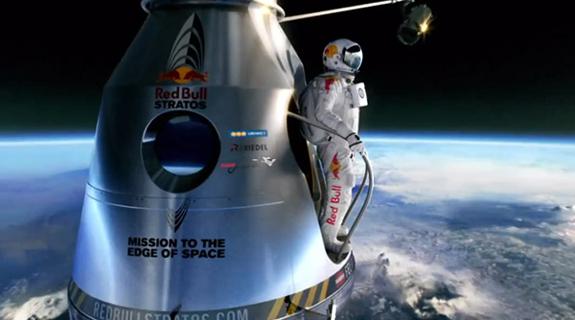Happening this Wednesday, at 9:00 a.m. in Salon A, the PromaxBDA: The Conference session, “PromaxBDA Innovations Committee Presents: Driving Viewers and Revenue with Creative Social TV Strategies,” will address the enormous opportunities in second-screen engagement.
In preparation for that session, we examine a recent campaign that leveraged social media to great success: The impossible-to-miss Red Bull Stratos campaign.
Parachuting out of a plane is old hat. Taking a leap out of a helium-balloon-powered capsule nearly 128,000 feet up is a knock-your-socks-off event. But Red Bull did not want its “Stratos Mission to the Edge of Space” date with destiny to be relegated to science fiction. Nor did it want resident leaper and daredevil Felix Baumgartner to be regarded mainly as someone taking part in a publicity stunt for his own means and gains.
To that end, the Stratos Mission took about seven years from inception to event, with the last three being an intense financial and science-based push to the finish line. Red Bull not only brought in a highly respected support crew – including Col. Joe Kittinger (who held the previous freefall record); the David Clark Co. to design Baumgartner’s “space suit”; and Sage Cheshire Aerospace (Lancaster, Calif.) to create the capsule. When full-on tests were conducted beginning in 2009, Red Bull embraced the power of social media to enable people to track and monitor the progress. The ensuing conversation – which at its height had a total of more than 35 million followers on Facebook, Twitter, Instagram, Foursquare, Google+ and elsewhere, according to Red Bull – was the catalyst that led an ever-growing number of print and TV media from around the world to cover the event as news.
When Baumgartner dropped from his capsule on Oct. 14, 2012, the descent was watched by more than 8 million viewers in real time on YouTube, according to Red Bull. Research and analyst firm Taykey, based in New York, later did a study which showed that at its apex, some 1% of all online conversations worldwide were about Baumgartner, Red Bull and the Stratos Mission: 54% on Twitter, 26% on Facebook, 6% on blogs and 14% on other video sites.
Baumgartner set numerous records – including highest freefall altitude (127,852.4 feet) and fastest speed achieved by a human during freefall (843.6 mph/Mach 1.25) – and some of the technology used will be studied and potentially incorporated into future government-sanctioned space missions.
As for the marketing side of Red Bull’s strategy, that too should be deemed a success. According to the London Telegraph, “Baumgartner’s skyfall must also be chalked up as a triumph for public relations over advertising and more orthodox sponsorship activity, albeit one that carried considerable downside risk. For all their billion-dollar budgets and the boon of the Olympics, surely no global brand will receive a more palpable and efficient shot in the arm than Red Bull [in 2012]. Why buy media if you can instead make it flock to your door?”
Barry Janoff is director of sports media marketing initiatives for PromaxBDA. He also is the executive editor for NYSportsJournalism.com which covers national sports marketing, business and media news; and a contributing writer for Yahoo! and MediaPost.
Tags:













































__twocolumncontent.jpg)











